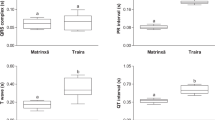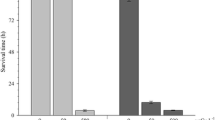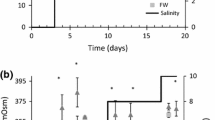Abstract
The lethality, anaesthetic and physiological effects of ‘pulsed’ cyanide (CN-) exposures to a common tropical marine fish Dascyllus aruanus were assessed. Cyanide (25 and 50 mg l-1) was applied as pulses (10, 60 and 120 s) to fish under non-stressed and stressed (by chasing and/or placing fish under hypoxic stress) conditions. Following treatment, the time until recovery and the percent survival were determined. The fish were allowed a 2.5 week recovery period from the treatments at which time four physiological end-points were measured: (1) the blood haemoglobin content, (2) the percent blood O-2 content, (3) the liver rhodonase activity and (4) the liver O2 consumption rate. The greater the CN- concentration and exposure time, the longer the recovery time. Non-stressed fish exposed to 10 s pulses of 25 mg l-1 of CN- fully recovered within 4 min whereas fish exposed for 60 s and 50 mg l-1 of CN- required up to 50 min for full recovery. Exposure for 120 s at 25 and 50 mg l-1 of CN- proved lethal. Under stressed conditions, previously non-lethal exposures (60 s and 50 mg l-1) were lethal. Of the physiological end-points, only the liver O2 consumption rate was indicative of previous CN- exposure. Under non-stressed conditions, pulsed exposures at 25 and 50 mg l-1 of CN- for 10 and 60 s significantly reduced the liver O2 consumption rates (ANOVA; p < 0.05). Under stressed conditions, the liver O2 consumption rates were significantly greater (maximum rates up to 17-fold greater) than the control fish (ANOVA; p < 0.05). We conclude, therefore, that environmentally relevant exposures of CN- can adversely effect fish and this affect can be measured 2.5 weeks post-exposure. Importantly, the combined effects of exposure and stress both increased the mortality and placed an appreciable metabolic load on the fish as indicated by the elevated liver O2 consumption rates. Handling stress in combination with anaesthetic CN- doses could in part explain the delayed mortality reportedly associated with CN- use in the tropical fish trade. The significance of the elevated liver O2 consumption rates on the survival of CN--exposed fish is unknown
Similar content being viewed by others
REFERENCES
Alabaster, J.S., Shurben, D.G. and Mallett, M.J. (1983) The acute lethal toxicity of mixtures of cyanide and ammonia to smolts of salmon, Salmo salar L. at low concentrations of dissolved oxygen. Journal of Fish Biology 22, 215–222.
Andrews, C. (1990) The ornamental fish trade and fish conservation. Journal of Fish Biology 37 (Suppl. A), 53–59.
Anonymous (1994) 21st annual PSM: state of the industry report. PSM Spring.
Chew, S.F. and Ip, Y.K. (1992) Cyanide detoxification in the mudskipper, B. boddaerti. Journal of Experimental Biology 26, 1–8.
Dixon, D.G. and Leduc, G. (1981) Chronic cyanide poisoning of rainbow trout and its effects on growth, respiration and liver histopathology. Archives of Environmental Contamination and Toxicology 10, 117–131.
EPA (1991) Methods for Measuring the Acute Toxicity of Effluents and Receiving Waters to Freshwater and Marine Organisms. Cincinnati: EPA.
Graham, M. and Fletcher, G. (1986) High concentrations of methaemoglobin in five species of temperate marine teleosts. Journal of Experimental Zoology 239, 139–142.
Hall, K.C. and Bellwood, D.R. (1995) Histological effects of cyanide, stress and starvation on the intestinal mucosa of Pomacentrus coelestis, a marine aquarium fish species. Journal of Fish Biology 47, 438–454.
Lanno, R.P. (1990) The chronic toxicity of thiocyanate to rainbow trout and fathead minnow. PhD Thesis, University of Waterloo.
Leduc, G. (1984) Cyanides in water: toxicological significance. In Weber, L.J., ed., Aquatic Toxicology, Vol. 2, New York: Raven Press, pp. 153–224.
Milligan, C.L. and Wood, C.M. (1986) Tissue intracellular acid-base status and the fate of lactate after exhaustive burst exercise. Journal of Experimental Biology 123, 123–144.
Rubec, P.J. (1986) The effects of sodium cyanide on coral reefs and marine fish in the Philippines. In MacLean, J.L., Dizon, L.B. and Hosillos, L.V., eds, The First Asian Fisheries Forum, Manila: Asian Fisheries Society, pp. 297–302.
Rubec, P.J. and Pratt, V.R. (1984) Scientific data concerning the effects of cyanide on marine fish. Freshwater and Marine Aquarium 7, 5, 4–6, 78-80, 82-86, 90-91.
SAS Institute Inc. (1988) SAS/STAT User's Guide. Release 6.03 Edition. Cary, NC: SAS Institute Inc.
Westley, J. (1981) Thiosulphate: cyanide sulfurtransferase (rhodanese). In Colowick, S.P. and Kaplan, N.O., eds, Methods in Enzymology, Vol. 77, New York: Academic Press, pp. 285–291.
Author information
Authors and Affiliations
Rights and permissions
About this article
Cite this article
Hanawa, M., Harris, L., Graham, M. et al. Effects of cyanide exposure on Dascyllus aruanus, a tropical marine fish species: lethality, anaesthesia and physiological effects. Aquarium Sciences and Conservation 2, 21–34 (1998). https://doi.org/10.1023/A:1009672626012
Issue Date:
DOI: https://doi.org/10.1023/A:1009672626012




